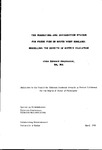THE MARKETING AND DISTRIBUTION SYSTEM FOR FRESH FISH IN SOUTH WEST ENGLAND: MODELLING THE EFFECTS OF SUPPLY VARIATION
| dc.contributor.author | Slaymaker, John Edward | |
| dc.contributor.other | Plymouth Business School | en_US |
| dc.date.accessioned | 2013-10-30T11:35:04Z | |
| dc.date.available | 2013-10-30T11:35:04Z | |
| dc.date.issued | 1988 | |
| dc.identifier | NOT AVAILABLE | en_US |
| dc.identifier.uri | http://hdl.handle.net/10026.1/2466 | |
| dc.description.abstract |
The distribution system in the fishing industry has attracted little attention from academics in comparison to the catching sector. This realisation came in the early 1980's with questions being raised about system efficiency and the identification of problems. A lack of understanding of the distribution system led to various calls for an investigation. This research builds on existing understanding by identifying the distribution system in Devon and Cornwall and develops a modelling framework with forecasting properties within which distribution system problems can be analysed. A review of the marketing and distribution literature reveals that system efficiency and the impacts of changes in external conditions are important areas for study. The literature also reveals that few attempts have been made to develop analytical and conceptual modelling frameworks that enable the study of these phenomena in existing distribution systems. Attempts that have been made suffer from conceptual and data problems. The research identities the major features of the fresh fish distribution system, especially the structural determinants including lack of standardisation and variability of supply. Studies of the system in the United Kingdom and overseas are found to be descriptive, concentrating upon trends and past problems. Few modelling approaches have been used or developed. The system in Devon and Cornwall is identified through interview techniques and presented in quantitative terms. From an identification of the system, it is determined that a model should focus on the port merchant sector and have the ability to explain and forecast the effects of supply variation. Econometric methods are used to develop a model with exogenous supply and seasonality characteristics which when combined with sample data on costs and pricing provides a method of analysis and forecasting. The research discusses the wide range of applications possible with the model developed. | en_US |
| dc.description.sponsorship | University of Exeter | en_US |
| dc.language.iso | en | en_US |
| dc.publisher | University of Plymouth | en_US |
| dc.title | THE MARKETING AND DISTRIBUTION SYSTEM FOR FRESH FISH IN SOUTH WEST ENGLAND: MODELLING THE EFFECTS OF SUPPLY VARIATION | en_US |
| dc.type | Thesis | |
| plymouth.version | Full version | en_US |
| dc.identifier.doi | http://dx.doi.org/10.24382/4296 | |
| dc.identifier.doi | http://dx.doi.org/10.24382/4296 |
Files in this item
This item appears in the following Collection(s)
-
01 Research Theses Main Collection
Research Theses Main


